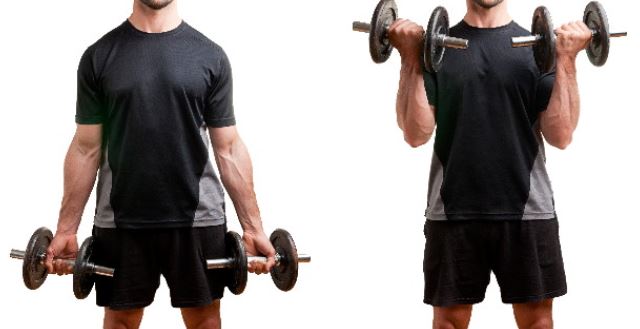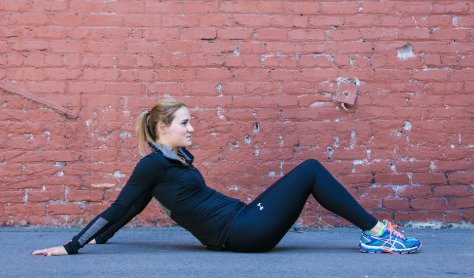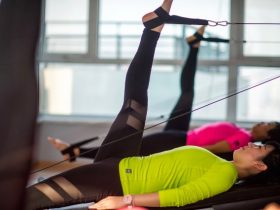Introduction
The Biceps Tendon connects the biceps muscles, the single bone in the elbow, and the two bones in the shoulder. These sections of the human body need special attention while performing some exercises. Tendons are fibrous tissues that connect the bones with the muscles. It also connects body structures, such as eyeballs, to the muscles for moving one’s particular body portion with minute direction from the brain.
Biceps tendonitis is caused due to the inflammation of the biceps tendons. It happens when there is a sudden increase in weight, especially amongst the gym-goers who are less conscious about weight lifting. It also occurs amongst athletic patients aged more than 35 or ordinary people aged more than 65 years.
Biceps tendonitis can be cured with specific exercises, even at home. You do not need heavy machines or anything special to perform those exercises that we will discuss below. With these exercises, one can quickly get rid of the pain in the biceps muscles.
What Is Bicep Tendonitis?
Biceps tendonitis is the augmentation of the tendon near the long end of the muscles in the biceps. Biceps tendonitis is caused by the normal ageing of the athletics or their overhead training periods. It arrives at the shoulders that can reason a tremendous amount of pain in a patient suffering from bicep tendonitis. Inflammation of the muscle in the biceps is also known as the beginning of bicep tendinitis.
This is primarily amongst 5 per cent of the athletics who are suffering from this physical problem. Superior Labrum Anterior generally accompanies biceps tendonitis to Posterior (SLAP). Biceps tendonitis is a syndrome of over-practice commonly noticed in patients who are athletic and over 35 years old and ordinary people who are more than 65 years old.
Diagnosis
Patients suffering from biceps tendonitis commonly have complained of having acute pain in their shoulder. This pain occurs at the groove of the biceps and then radiates to the deltoid muscle or down in hand to a radial portion. This pain is sometimes challenging to locate as it keeps changing its position around the shoulder and the arms.
A patient’s suffering worsens during the nighttime if they mistake sleeping on the affected shoulder and arm. Instability in the deltoid causes a significant problem in this disease. The most common procedure to follow for diagnosis of biceps tendonitis is MRI, Arthrography, Radiography, Bicipital groove view radiography, and Ultrasonography.
Know how to identify biceps tendonitis from the ortho experts here.
Some Effective Exercise for Biceps Tendonitis
Biceps tendonitis, the inflammation of deltoid tissues, can cause swelling, redness around the outside of the shoulder, and severe pain. It can be treated with these simple exercises. Due to prolonged use, especially in athletics, the tendon sheath becomes augmented. Consequently, the treatment it requires is resting, while simple exercises can be performed to heal the tissues and keep the shoulders and biceps flexible and robust.
There are several DO’s and DON’Ts that accompany biceps tendonitis. Here is a quick view.
- Vertical Shoulder Flexion: This simple and easy exercise will help you maintain its sheer range and motion while the biceps tendonitis is healing. At the very first, you need to stand upright when the injured hand should hang loose at the side.
After that, you should slowly raise the arm and bring it in near your body till the moment it falls vertically over the head. You have to make sure to keep your elbow straight. It would be best to repeat this exercise 15 times and do two sets of the same. - Biceps Curls

This exercise helps you to get your elbow flexible and also keeps up the Strength of the biceps. Fording this exercise, you need 5 to 8 pounds of weight in your hand. First, you stand up straight with the injured hand on your side with the palm facing you. Then, the injured hand should be bent towards your elbow. You need to hold this position of your palm for at least 30 seconds.
Do not hold your breath; you need to keep breathing. After that, you should release your hand slowly downwards and repeat. This exercise should be done in two sets, 8 to 12 times repeating in each set. Once you do this exercise daily, you will start feeling relaxation in your injured arm, and it will give you relief from the bicep tendonitis pain. - Biceps Stretch

Stretching the biceps will make your tendonitis feel worse, and it will keep the biceps away from tightening. It would help if you stood straight against the wall for this exercise, maintaining 15 centimetres or 6 inches distance from it. It would help if you raised your injured arm in a horizontal shape against the wall according to your shoulder height.
After that, you should place the hand’s thumb side at the border while you will keep your palm down towards your leg. Then you need to rotate your body in the opposite direction of the wall until you feel a stretch in your body. Hold this position for 12 to 15 seconds. It would help if you repeated this exercise 3 times daily until you feel improvement in your bicep tendonitis. - Elbow Flexion and Extension
This exercise is exclusively for the elbow. You need to get your palm bent and get it closer to your shoulder. Then release the arm and push it down slowly as much as you can and strengthen it. You have to repeat this exercise 15 times in 2 sets. Daily doing of it will make your elbow pretty flexible. - The Shoulder Internal Rotation
Internal rotation involves the movement of your arm and shoulder. In this exercise, the shoulder socket is the most affected area. The bicep also has a vital role to play in this exercise. Your hand will move from the front to back to make a proper adjustment of the shoulder muscles. At first, you need to stand straight sidewise a door and hold a yardstick that should be attached to the door.
Your injured hand has to be on the side of the door. Then you pull the yardstick that should be knotted with the door at your waist level. Your elbow has to be bent at 90 degrees against the door towards your belly. And you need to hold that position for 15 seconds and then release it slowly. You need to repeat this exercise 12 times each in 2 sets. - The Shoulder External Rotation
This exercise works as just the opposite of the internal shoulder rotation. You need to stand straight next to the sidewise of your injured hand, then tie the yardstick to the door at your waist level. Your writing should be at a 90-degree angle against the door. After that, place your hand upon your stomach and gently pull the tubing end of the yardstick until you feel stretch in your elbow.
Release it gently and then again repeat the same. These two internal and external stretches of your hand will have an immense impact on the bicep tendonitis. You will need to repeat this exercise the same as the internal one daily. Keeping a continuation of these will give you relaxation and Strength in your shoulder and elbow. - Forearm Twist
Thus, exercise helps in making the tendon glide smooth and keep your muscles flexible. At the very first, you need to bend your injured arm at a 90-degree angle sidewise. Then you have to turn the arm up to face upwards and then hold the position at least for 5 to 8 seconds.
Do not push your limit. be very careful about that. Then slowly put your hand downwards and again hold the position for the same period. This exercise should be done in 3 sets daily. - Sleeper Stretch
You need to lie down on your injured side for this exercise. Place a pillow downside your head, and then slowly bend your knees according to your stability and comfort. Then you need to turn your injured arm’s elbow, and the fingers of that arm should face the ceiling.
After that, push the injured arm towards the floor very slowly with the help of the other hand. Hold the position and resist it for at least 30 seconds to stretch and maintain your shoulder blades squeezed together as you continue with the exercise. Hold every stretch for 30 seconds and repeat it in 2-3 sets daily. - Reclining External Rotation
You need to lie down on your injured side for this exercise. Then you extend the other arm of yours against the floor and put your head on this hand. Bend your knees according to your stability and for comfort. First, you bend the elbow of your injured arm in 90 degrees and rest the other hand on your other side.
During this session, your palm should have your face pointing. Then keep the injured elbow against your body up-rise your forearm parallel to the floor. Repeat this method at least 15 times. Keep enough rest between each set and then repeat it. You can also do this exercise with lightweight.
How to Avoid Biceps Tendonitis?
Every form of tendonitis is the gradual result of the ageing process. The more you age, the more you become prone to tendonitis. Bicep tendonitis is not something one can avoid just like that. You need to have proper knowledge about tendonitis to prevent the pain. Once you are above 30 years, you need to consider these below-mentioned points to avoid bicep tendonitis.
- Avoid Dead Lifts: Stop lifting weights whenever it starts hurting. If any particular movement seems hurtful to you, stop doing that then and there. We should not push our limits very hard. Being overweight can cause severe issues in muscles. So stop doing over the lifting of weight and maintain a safe distance from bicep tendonitis.
- Using Proper Form: When you can not stop the movement or restrict the direction of a weak muscle of your hand, you should consult orthopaedics to discuss some proper way of moving that muscle. It will prevent you from severe tendonitis.
- Building Strength Gradually: Sudden speed up in exercise or sudden increase in gym weight can become deadly for you. Be very cautious about increasing the reps and importance of your workout. Gaining Strength is always a slow but steady process. Our body takes a specific time to increase its Strength. So give that required time to your body and refrain from having muscle tendonitis.
- Warming up and Stretching: You need to stretch your injured arm every time before using it. Remember, warming up our body is very important before any heavy movement. And especially, when a part of our is injured, that needs special attention. Learn the effectiveness of bicep tendonitis stretches by clicking here.
- Break and Rest In-between: Intense gym sessions and athletic workouts need scheduled breaks between each set of the session. Our body muscles are systemized mechanically that can handle pressure to a certain level. Every human has a different level of tolerance. Overtime sessions can cause serious harm to the muscles. So proper break and rest are essential as much as working out our body.
- Maintaining a Healthy Weight: Doctors have found a stable link between tendon damage and excessive body weight. Maintaining a healthy weight can prevent muscle inflammation and bicep tendonitis.
- The practice of Good Shoulder Care: Bicep and shoulder tendonitis are often associated with other shoulder and biceps injuries. Taking precautions of shoulder while at the gym or doing athletic workouts will prevent you from having bicep tendonitis. You can consult an orthopaedic physician to know the proper ways of caring for your shoulder and biceps.
Conclusion
Tendonitis is caused by repetitive use or overuse of any particular muscle. When an athlete is above 30 years or an average person over 65 years ago, they need to be very cautious about the bicep tendonitis. The proper way of doing exercise and adequate knowledge about muscles can save one from severe injuries in their body. Bicep tendonitis can be cured with the light exercise we discussed in this article.











